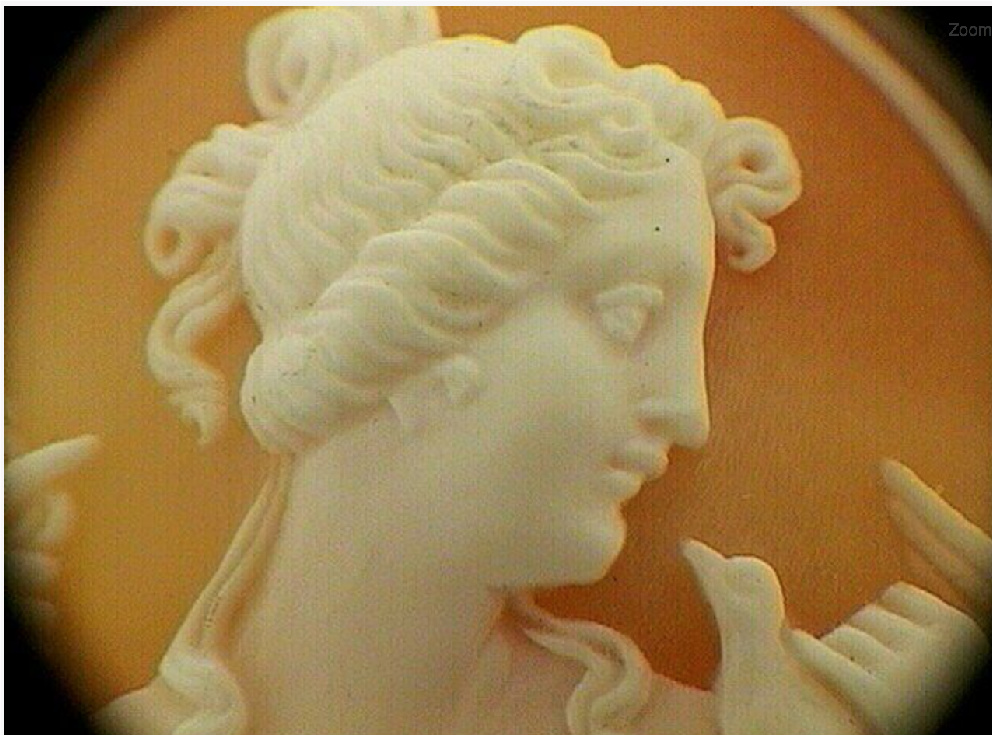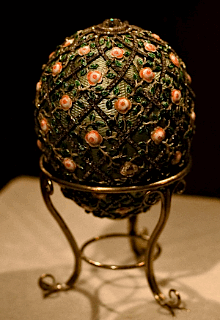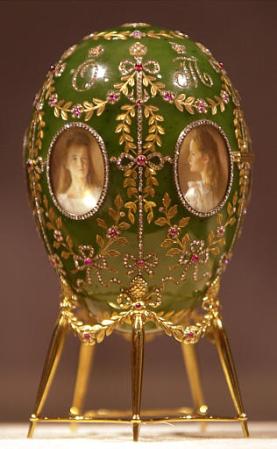Carl Faberge Eggs
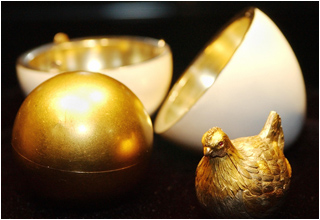 The First of Faberge Eggs was the Hen Egg in 1885 The First of Faberge Eggs was the Hen Egg in 1885 |
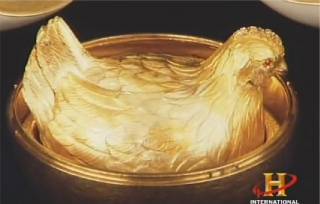 The Suprise Inside is a Hen The Suprise Inside is a Hen |
In the Catalogue of Faberge Easter Eggs that were made between 1885 and 1916, were Fifty-Four Imperial Eggs commissioned by the Tsars Alexander III and Nicholas II and described as faithfully as possible on these pages.
The Fabergé tradition all started when Alexander III first commissioned Peter Carl Fabergé (1846-1920) to make the Easter Surprise of 1885 one his Tsarina would never ever forget; the Tsar commissioned as a special Easter gift for the Tsarina, (who was born a Danish princess) a very special Easter egg surprise; inside the egg lay a golden egg - the Hen Egg symbolised love and rebirth and everlasting perfection.
Fabergé's first Imperial Easter egg was a copy of a similar egg, made of gold and opaque white enamel and containing a miniature hen, which you can still see today in the Danish royal collection of Rosenborg Castle in Copenhagen. A photo of the egg is at the top of this page.
Attracting the eye of Empress Maria Feodorovna with his striking reproductions of Russian archaeological treasures, Carl Faberge was given the title by the Empress in 1885: Supplier by Special Appointment to the Imperial Court
Not long after his appointment, Faberge created his first Imperial Easter egg for Tsar Alexander III, whose pleasure over the series of bejeweled treasures coincided tragically with the ignominious end to their reign.
Purveyor of Imperial Easter eggs for the Russian Royal Family, Faberge is dearly remembered for his Imperial eggs (and other fine objects) that combined hand-enameling with machine-made guilloche metal backgrounds and set with rose-cut diamonds after the rose-cut diamond was invented in the 1870s.
In 1917, the Russian Revolution brought a thunderstorm of violence and ended not only the Romanov dynasty but also brought down the House of Fabergé and the science of jewelry egology. The Bolsheviks seized the Fabergé workshops and their treasures and all production was closed down. Peter Carl Fabergé and his family fled from Russia. However, like most good things, their value just keeps increasing over time; the Power in Oldness!
Over the next 30 years, Fabergé produced more than 150,000 objects for the Romanov court, enabling him to employ 500 highly skilled craftsmen and expand his St. Petersburg firm with branches in Moscow, Kyiv, Odesa and also London.
Forty-seven of the fifty-four Imperial Russian Imperial eggs are known to exist. The unifying theme with most of the eggs is the tantalizing 'surprise' hidden inside each one.
What's Your Favorite Faberge Easter Egg?
Fabergé Easter egg jewels reveal the impeccable craftsmanship of Peter Carl Fabergé. Each one is a masterpiece of elegance, inventiveness, ingenuity, and craftsmanship. This is why the Fabergé eggs are on the list of the world's Famous Collections.
A New Fabergé Egg Every Year
The Imperial family loved them! The success of the idea is Fabergé Egg History resulting in an Imperial Commission for a new Fabergé egg every year producing an extraordinary series of fifty-four Imperial presentation Easter Eggs.
People of all ages and from all cultures fall in love with these Faberge Eggs and find the history of the Russian Easter egg tradition enthralling along with the history of their Imperial connections. So amazing are these eggs, that modern copies or fakes are faithfully produced complete with the trappings of fake Imperial provenance in an attempt to deceive the unsuspecting ...egg head.
The Full Catalogue of Imperial Faberge Eggs Can Be Found Here.
Where are the Faberge Eggs Now?
So what happened to the Imperial eggs? In the 1920s and '30s, when the Russian economy tanked, the country's new leaders, intent on making some quick rubles, began selling the Imperial eggs to international buyers.
Today, there are 10 eggs at the Kremlin Armory, nine at the Faberge Museum in St. Petersburg, five at the Virginia Museum of Fine Arts and three each at the Royal Collection in London and the Metropolitan Musem in New York. Two more are on display in Lausanne, Switzerland, two at Hillwood Estate in Washington, D.C., and two at the Walters Art Museum of Art, one in Monte Carlo, and one at the Faberge Museum in Baden-Baden, Germany. One is also owned by Hamad bin Khalifa Al Thani, the former Emir of Qatar.
Reference:
Solodkoff, A., V. Faberge, Octopus Publishing Group, 1988, London.
DailyPress.com - Virginia Museum explores works by Faberge http://www.dailypress.com/entertainment/galleriesandmuseums/dp-fea-faberge-20110706,0,1428058.story at 19th July 2011.
https://www.history.com/news/romanov-family-russia-mystery-faberge-easter-eggs
Return to the top of Faberge Eggs
Return to Antique Jewelry Investor Home Page
Join Us on The Cameo Tour to Italy
Express Your Interest, Fill out the Form and Get on the List Here...
